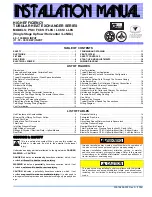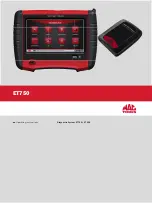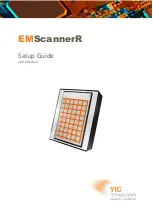
Lake Shore Model 370 AC Resistance Bridge User’s Manual
8.7.1.3
VDIF OVL (Differential Overload)
The input stage of the voltage measurement side of the instrument is a very high input impedance instrumentation
amplifier with a high gain of 1000 (10 at voltage excitations of 20 mV and above). If the combination of signal and
differential noise components cause the output of this stage to exceed 10 V peak, the differential overload error
(VDIF OVL) is displayed. The overload occurs at the “VDIF” point in the instrumentation amplifier circuit. Refer to
Figure 8-3 for the location of the “VDIF” monitoring point. The signal voltage can be viewed on an oscilloscope by
using the Monitor output described in Paragraph 4.7.4.
Usual causes of this error include:
1. An attempt to measure a resistance that is much greater (2 orders of magnitude) than the selected range.
2. An open connection of one or both of the voltage measurement leads.
3. Significant differential noise on current and/or voltage leads.
To resolve this condition, first verify that a reasonable resistance range has been selected for the measurement. Next,
verify the integrity of the voltage lead connections to the measured resistance. If the error persists, verify that the voltage
pair of leads is twisted and shielded. Likewise, the current pair of leads should be twisted and shielded. Twisted pair
wiring reduces the differential signals potentially created by environmental noise. However, there is no advantage gained
by twisting the current pair of leads together with the voltage pair of leads. When twisted leads are not an option (inside
a Dewar), the shielding must be verified adequate for the task. The Dewar itself can act as a shield when the case is
properly connected. Ensure that the experimental Dewar case is properly connected to the measurement common of the
instrument and earth ground. Refer to Installation Paragraph 3.4.4.
8.7.1.4
VMIX OVL (Mixer Overload)
Between the instrumentation amplifier section and the mixer portion of the phase sensitive detector are several gain
stages and a band-pass filter. If the combination of signal and all differential noise components cause the input to the
mixer to exceed 10 V peak, the mixer overload error is displayed. The overload occurs at the “VMIX” point in the
instrumentation amplifier circuit. Refer to Figure 8-3 for the location of the “VMIX” monitoring point. The signal
voltage can be viewed on an oscilloscope by using the Monitor output described in Paragraph 4.7.4. This ensures linear
operation within the phase-sensitive detector. This is likely to be the most common error message displayed. It is not
uncommon to see this error temporarily when changing measurement parameters.
Usual causes for this error are include:
1. A temporary transient during current, voltage or range change.
2. An attempt to measure a resistance that is greater (1 order of magnitude) than the selected range.
3. A differential noise level that is lower than the “VDIF” overload level but high enough after the gain stages to
exceed the dynamic range of the phase-sensitive detector.
To resolve this condition, first verify that a reasonable resistance range has been selected for the measurement. Next,
verify the integrity of the voltage lead connections to the measured resistance. If the error persists, verify that the voltage
pair of leads is twisted and shielded. Likewise, the current pair of leads should be twisted and shielded. Twisted pair
wiring reduces the differential signals potentially created by environmental noise. However, there is no advantage gained
by twisting the current pair of leads together with the voltage pair of leads. When twisted leads are not an option (inside
a Dewar), the shielding must be verified adequate for the task. The Dewar itself acts as a shield when the case is properly
connected. Ensure that the experimental Dewar case is properly connected to the measurement common of the
instrument and earth ground. Refer to Installation Paragraph 3.4.4.
8.7.1.5
R. OVER (Range Over)
This message indicates that the selected resistance range is lower than that required for the measured resistance. To
resolve the condition, simply increase the resistance range.
Service
8-5
Содержание 370
Страница 22: ...Lake Shore Model 370 AC Resistance Bridge User s Manual 1 12 Introduction This Page Intentionally Left Blank ...
Страница 60: ...Lake Shore Model 370 AC Resistance Bridge User s Manual 3 16 Installation This Page Intentionally Left Blank ...
Страница 106: ...Lake Shore Model 370 AC Resistance Bridge User s Manual 5 12 Advanced Operation This Page Intentionally Left Blank ...
















































